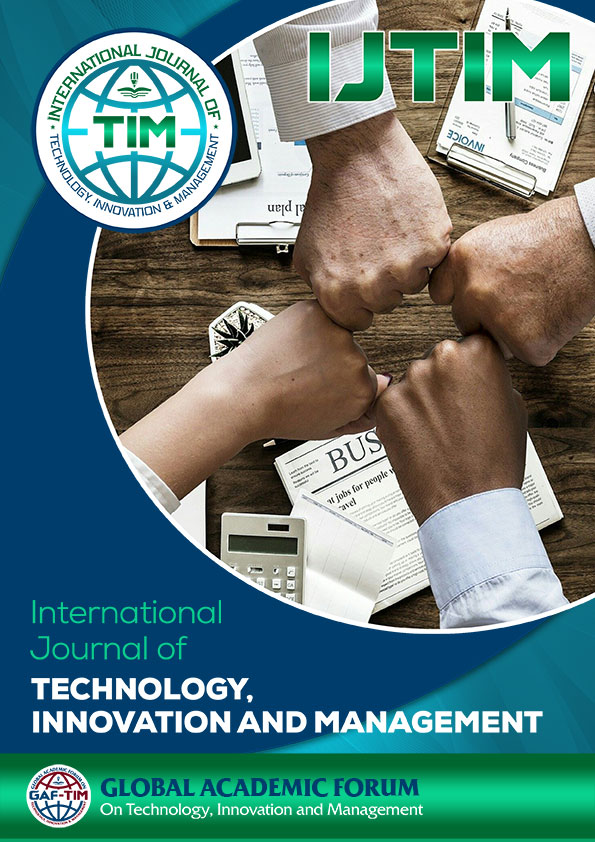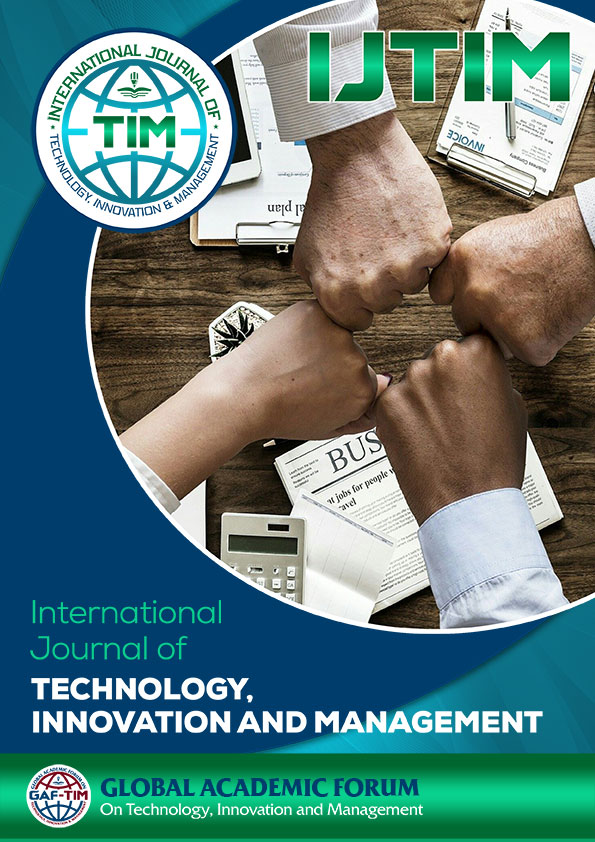Marketing Agility, Innovation Capabilities, and Customer Satisfaction
DOI:
https://doi.org/10.54489/yt7g0s43Keywords:
Marketing agility, innovation capabilities, quality, customer satisfaction, PalestineAbstract
Managers and scholars have recently shown interest in marketing agility. Nevertheless, the current body of research on marketing agility has primarily focused on the influence of marketing agility on a company’s performance while overlooking the potential influence of marketing agility on innovation capabilities and customer satisfaction. In addition, earlier research has focused on analyzing marketing agility from the company's standpoint, neglecting to consider the influence of marketing agility on the consumer from the customer's standpoint. This study seeks to address this knowledge gap by investigating the influence of marketing agility on innovation capabilities. Additionally, it analyzes the impact of innovation capabilities on customer satisfaction. The study focused on owners and senior managers of industrial enterprises operating in Palestine. The sample size consisted of 162 senior managers. The Structural equation modeling (SEM) technique was used to test hypotheses. The findings indicate that marketing agility has a significant positive impact on innovation capabilities. Moreover, innovation capabilities positively influence customer satisfaction. Therefore, a series of suggestions are given to senior managers of organizations to assist in promoting organizational actions that improve marketing agility and innovation capabilities, which are suitable for the overall context of customer demand development.
References
Abrunhosa, A., & Moura E Sá, P. (2008). Are TQM principles supporting innovation in the Portuguese footwear industry? Technovation, 28(4), 208-221. https://doi.org/https://doi.org/10.1016/j.technovation.2007.08.001
Agag, G., Shehawy, Y. M., Almoraish, A., Eid, R., Chaib Lababdi, H., Gherissi Labben, T., & Abdo, S. S. (2024). Understanding the relationship between marketing analytics, customer agility, and customer satisfaction: A longitudinal perspective. Journal of Retailing and Consumer Services, 77, 103663. https://doi.org/https://doi.org/10.1016/j.jretconser.2023.103663
AlTaweel, I. R., & Al-Hawary, S. I. (2021). The Mediating Role of Innovation Capability on the Relationship between Strategic Agility and Organizational Performance. 13(14), 7564. https://www.mdpi.com/2071-1050/13/14/7564
Ardyan, E. (2016). Market sensing capability and SMEs performance: The mediating role of product innovativeness success. DLSU Business Economics Review, 25(2), 79-97.
Athanassopoulos, A., Gounaris, S., & Stathakopoulos, V. (2001). Behavioural responses to customer satisfaction: an empirical study. European Journal of Marketing, 35(5/6), 687-707. https://doi.org/10.1108/03090560110388169
Ayoub, H. F., & Abdallah, A. B. (2019). The effect of supply chain agility on export performance. Journal of Manufacturing Technology Management, 30(5), 821-839. https://doi.org/10.1108/JMTM-08-2018-0229
Bahri-Ammari, N., & Soliman, K. S. (2016). The effect of CRM implementation on pharmaceutical industry’s profitability. Management Research Review, 39(8), 854-878. https://doi.org/10.1108/MRR-11-2014-0258
Bedford, A., Ma, L., Ma, N., & Vojvoda, K. (2021). Patenting activity or innovative originality? Accounting & Finance, 61(3), 4191-4207. https://doi.org/https://doi.org/10.1111/acfi.12730
Benapudi, N., & Leone, R. (2003). Psychological Implications of Customer Participation in Co-Production. Journal of Marketing, 67, 14-28.
Beraha, A., Bingol, D., Canbolat, E., & Szczygiel, N. (2018). The effect of strategic flexibility configurations on product innovation. European Journal of Management and Business Economics, 27. https://doi.org/10.1108/EJMBE-02-2018-0028
Carbonell, P., & Rodríguez Escudero, A. I. (2010). The effect of market orientation on innovation speed and new product performance. Journal of Business & Industrial Marketing, 25(7), 501-513. https://doi.org/10.1108/08858621011077736
Chang, S.-C. L., Ru-Jen Chen, Jung-Hui Huang, Li-Hua. (2005). Manufacturing flexibility and manufacturing proactiveness: Empirical evidence from the motherboard industry. Industrial Management and Data Systems, 105, 1115-1132.
Charterina, J., Basterretxea, I., & Landeta, J. (2016). Types of embedded ties in buyer-supplier relationships and their combined effects on innovation performance. Journal of Business & Industrial Marketing, 31(2), 152-163. https://doi.org/10.1108/JBIM-04-2014-0071
Chen, Y.-C., Li, P.-C., & Evans, K. R. (2012). Effects of interaction and entrepreneurial orientation on organizational performance: Insights into market driven and market driving. Industrial Marketing Management, 41(6), 1019-1034. https://www.sciencedirect.com/science/article/pii/S0019850112000363
Combe, I. (2012). “Marketing and flexibility”: debates past, present and future. European Journal of Marketing, 46(10), 1257-1267. https://doi.org/10.1108/03090561211248116
Cronin, J. J., Brady, M. K., & Hult, G. T. M. (2000). Assessing the effects of quality, value, and customer satisfaction on consumer behavioral intentions in service environments. Journal of Retailing, 76(2), 193-218. https://www.sciencedirect.com/science/article/pii/S0022435900000282
Day, G. S. (1994). The Capabilities of Market-Driven Organizations. Journal of Marketing, 58(4), 37-52. https://doi.org/10.1177/002224299405800404
Eckstein, D., Goellner, M., Blome, C., & Henke, M. (2015). The performance impact of supply chain agility and supply chain adaptability: the moderating effect of product complexity. International Journal of Production Research, 53(10), 3028-3046. https://doi.org/10.1080/00207543.2014.970707
Fang, Chang, E., Ou, C.-C., & Chou, C.-H. (2014). Internal market orientation, market capabilities and learning orientation. European Journal of Marketing, 48, 170-192.
Fang, E. (2008). Customer Participation and the Trade-Off Between New Product Innovativeness and Speed to Market. Journal of Marketing, 72.
Ganguly, A., Kumar, C., Saxena, G., & Talukdar, A. (2020). Firms’ Reputation for Innovation: Role of Marketing Capability, Innovation Capability, and Knowledge Sharing. Journal of Information & Knowledge Management, 19(02), 2050004. https://doi.org/10.1142/S0219649220500045
Garrett, R. P., Covin, J. G., & Slevin, D. P. (2009). Market responsiveness, top management risk taking, and the role of strategic learning as determinants of market pioneering. Journal of Business Research, 62(8), 782-788. https://www.sciencedirect.com/science/article/pii/S0148296308001422
Ginting, Y., Chandra, T., Miran, I., & Yusriadi, Y. (2023). Repurchase intention of e-commerce customers in Indonesia: An overview of the effect of e-service quality, e-word of mouth, customer trust, and customer satisfaction mediation. International Journal of Data Network Science, 7(1), 329-340.
Gligor, D., & Holcomb, M. (2012). Antecedents and consequences of supply chain agility: establishing the link to firm performance. Journal of Business logistics, 33(4), 295-308.
Grewal, R., & Tansuhaj, P. (2001). Building organizational capabilities for managing economic crisis: The role of market orientation and strategic flexibility. Journal of Marketing, 65(2), 67-80.
Hagen, B., Zucchella, A., & Ghauri, P. N. (2019a). From fragile to agile: marketing as a key driver of entrepreneurial internationalization. International Marketing Review.
Hagen, B., Zucchella, A., & Ghauri, P. N. (2019b). From fragile to agile: marketing as a key driver of entrepreneurial internationalization. International Marketing Review, 36(2), 260-288. https://doi.org/10.1108/IMR-01-2018-0023
Hair, J., Black, W., Anderson, R., & Babin, B. (2018). Multivariate Data Analysis. Cengage Learning EMEA.
Hair Jr, J., Page, M., & Brunsveld, N. (2019). Essentials of business research methods. Routledge.
Haumann, T., Quaiser, B., Wieseke, J., & Rese, M. (2014). Footprints in the Sands of Time: A Comparative Analysis of the Effectiveness of Customer Satisfaction and Customer–Company Identification over Time. Journal of Marketing, 78(6), 78-102. https://doi.org/10.1509/jm.13.0509
Hurley, R. F., & Hult, G. T. M. (1998). Innovation, Market Orientation, and Organizational Learning: An Integration and Empirical Examination. Journal of Marketing, 62(3), 42-54. https://doi.org/10.1177/002224299806200303
Jiménez-Jiménez, D., & Sanz-Valle, R. (2011). Innovation, organizational learning, and performance. Journal of Business Research, 64(4), 408-417. https://www.sciencedirect.com/science/article/pii/S0148296310001906
Kalaignanam, K., Tuli, K. R., Kushwaha, T., Lee, L., & Gal, D. (2021a). Marketing Agility: The Concept, Antecedents, and a Research Agenda. 85(1), 35-58. https://journals.sagepub.com/doi/abs/10.1177/0022242920952760
Kalaignanam, K., Tuli, K. R., Kushwaha, T., Lee, L., & Gal, D. (2021b). Marketing Agility: The Concept, Antecedents, and a Research Agenda. Journal of Marketing, 85(1), 35-58. https://doi.org/10.1177/0022242920952760
Kamasak, R., Yavuz, M., Karagulle, A. O., & Agca, T. (2016). Importance of Strategic Flexibility on the Knowledge and Innovation Relationship: An Emerging Market Study. Procedia - Social and Behavioral Sciences, 229, 126-132. https://www.sciencedirect.com/science/article/pii/S1877042816310564
Keith, T. Z. (2019). Multiple regression and beyond: An introduction to multiple regression and structural equation modeling. Routledge.
Khan, H. (2020a). Is marketing agility important for emerging market firms in advanced markets? International Business Review, 29(5), 17-33. https://www.sciencedirect.com/science/article/pii/S0969593120300780
Khan, H. (2020). Is marketing agility important for emerging market firms in advanced markets? International Business Review, 29(5), 101733.
Khan, H. (2020b). Is marketing agility important for emerging market firms in advanced markets? International Business Review, 29, 101733. https://doi.org/10.1016/j.ibusrev.2020.101733
Kotler, P., & Keller, K. L. (2015). Marketing management, global edition. Pearson Education UK.
Kunz, W., Schmitt, B., & Meyer, A. (2011). How does perceived firm innovativeness affect the consumer? Journal of Business Research, 64(8), 816-822. https://www.sciencedirect.com/science/article/pii/S0148296310002055
Lages, L. F., Asseraf, Y., & Shoham, A. (2019). Assessing the drivers and impact of international marketing agility. International Marketing Review, 36(2), 289-315. https://doi.org/10.1108/IMR-12-2017-0267
Lawson, B., & Samson, D. (2001). Developing innovation capability in organisations: a dynamic capabilities approach. International journal of innovation management, 5(03), 377-400.
Lei, H., Nguyen, T. T., & Le, P. B. (2019). How knowledge sharing connects interpersonal trust and innovation capability. Chinese Management Studies, 13(2), 276-298. https://doi.org/10.1108/CMS-06-2018-0554
Lim, L. G., Tuli, K. R., & Grewal, R. (2020). Customer Satisfaction and Its Impact on the Future Costs of Selling. Journal of Marketing, 84(4), 23-44. https://doi.org/10.1177/0022242920923307
Lin, J.-H., & Wang, M.-Y. (2015). Complementary assets, appropriability, and patent commercialization: Market sensing capability as a moderator. Asia Pacific Management Review, 20(3), 141-147. https://www.sciencedirect.com/science/article/pii/S1029313214000141
Lin, R. J., Chen, R. H., & Kuan‐Shun Chiu, K. (2010). Customer relationship management and innovation capability: an empirical study. Industrial Management & Data Systems, 110(1), 111-133. https://doi.org/10.1108/02635571011008434
Mavondo, F. T., Chimhanzi, J., & Stewart, J. (2005). Learning orientation and market orientation. European Journal of Marketing, 39(11/12), 1235-1263. https://doi.org/10.1108/03090560510623244
Migdadi, M. M. (2022). Knowledge management processes, innovation capability and organizational performance. International Journal of Productivity and Performance Management, 71(1), 182-210. https://doi.org/10.1108/IJPPM-04-2020-0154
Morgan, N. A., Slotegraaf, R. J., & Vorhies, D. W. (2009). Linking marketing capabilities with profit growth. International Journal of Research in Marketing, 26(4), 284-293. https://www.sciencedirect.com/science/article/pii/S0167811609000664
Mu, J. (2015). Marketing capability, organizational adaptation and new product development performance. Industrial Marketing Management, 49, 151-166. https://doi.org/https://doi.org/10.1016/j.indmarman.2015.05.003
Najafi-Tavani, S., Sharifi, H., & Najafi-Tavani, Z. (2016). Market orientation, marketing capability, and new product performance: The moderating role of absorptive capacity. Journal of Business Research.
Nasution, H. N., Mavondo, F. T., Matanda, M. J., & Ndubisi, N. O. (2011). Entrepreneurship: Its relationship with market orientation and learning orientation and as antecedents to innovation and customer value. Industrial Marketing Management, 40(3), 336-345. https://doi.org/https://doi.org/10.1016/j.indmarman.2010.08.002
Nemkova, E. (2017). The impact of agility on the market performance of born-global firms: An exploratory study of the ‘Tech City’innovation cluster. Journal of Business Research, 80, 257-265.
O'Sullivan, D., & McCallig, J. (2012). Customer satisfaction, earnings and firm value. European Journal of Marketing, 46(6), 827-843. https://doi.org/10.1108/03090561211214627
Osei, C., Amankwah-Amoah, J., Khan, Z., Omar, M., & Gutu, M. (2019). Developing and deploying marketing agility in an emerging economy: the case of Blue Skies. International Marketing Review, 36(2), 190-212. https://doi.org/10.1108/IMR-12-2017-0261
Ramasesh, R., Kulkarni, S., & Jayakumar, M. (2001). Agility in manufacturing systems: an exploratory modeling framework and simulation. Integrated Manufacturing Systems, 12(7), 534-548. https://doi.org/10.1108/EUM0000000006236
Roberts, N., & Grover, V. (2012). Investigating firm's customer agility and firm performance: The importance of aligning sense and respond capabilities. Journal of Business Research, 65(5), 579-585. https://www.sciencedirect.com/science/article/pii/S0148296311000427
Rosenberg, L. J., & Czepiel, J. A. (1984). A marketing approache for customer retention Journal of Consumer Marketing, 1(2), 45-51. https://doi.org/10.1108/eb008094
Sandvik, I. L., & Sandvik, K. (2003). The impact of market orientation on product innovativeness and business performance. International Journal of Research in Marketing, 20(4), 355-376. https://www.sciencedirect.com/science/article/pii/S0167811603000508
Sardeshmukh, S. R., & Vandenberg, R. J. (2016). Integrating Moderation and Mediation: A Structural Equation Modeling Approach. Organizational Research Methods, 20(4), 721-745. https://doi.org/10.1177/1094428115621609
Sharma, M., Sushil, P., & Jain, P. K. (2010). Revisiting Flexibility in Organizations: Exploring its Impact on Performance. Global Journal of Flexible Systems Management, 11, 51-68.
Slater, S., & Narver, J. (2012). Intelligence and Superior Customer Value. Journal of the Academy of Marketing Science, 28, 120-127.
Sorescu, A. B., & Spanjol, J. (2008). Innovation's Effect on Firm Value and Risk: Insights from Consumer Packaged Goods. Journal of Marketing, 72(2), 114-132. https://doi.org/10.1509/jmkg.72.2.114
Stachowiak, A., & Oleśków-Szłapka, J. (2018). Agility Capability Maturity Framework. Procedia Manufacturing, 17, 603-610. https://www.sciencedirect.com/science/article/pii/S2351978918312198
Swaminathan, V., Sorescu, A., Steenkamp, J.-B. E. M., O’Guinn, T. C. G., & Schmitt, B. (2020). Branding in a Hyperconnected World: Refocusing Theories and Rethinking Boundaries. Journal of Marketing, 84(2), 24-46. https://doi.org/10.1177/0022242919899905
Teece, D., Peteraf, M., & Leih, S. (2016). Dynamic Capabilities and Organizational Agility: Risk, Uncertainty, and Strategy in the Innovation Economy. California Management Review, 58(4), 13-35. https://doi.org/10.1525/cmr.2016.58.4.13
Troy, L. C., Szymanski, D. M., & Varadarajan, P. R. (2001). Generating New Product Ideas: An Initial Investigation of the Role of Market Information and Organizational Characteristics. Journal of the Academy of Marketing Science, 29(1), 89-101. https://journals.sagepub.com/doi/abs/10.1177/0092070301291006
Wang, C. L., & Ahmed, P. K. (2004). The development and validation of the organisational innovativeness construct using confirmatory factor analysis. European Journal of Innovation Management, 7(4), 303-313. https://doi.org/10.1108/14601060410565056
Wei, Y., Samiee, S., & Lee, R. (2014). The influence of organic organizational cultures, market responsiveness, and product strategy on firm performance in an emerging market. Journal of the Academy of Marketing Science, 42, 49-70.
Wei, Y., & Wang, Q. (2011). Making sense of a market information system for superior performance: The roles of organizational responsiveness and innovation strategy. Industrial Marketing Management, 40(2), 267-277. https://www.sciencedirect.com/science/article/pii/S0019850110001227
Williams, A., & Naumann, E. (2011). Customer satisfaction and business performance: A firm-level analysis. Journal of Services Marketing, 25, 20-32.
Zahoor, N., & Lew, Y. K. (2023). Enhancing international marketing capability and export performance of emerging market SMEs in crises: strategic flexibility and digital technologies. International Marketing Review, 40(5), 1158-1187. https://doi.org/10.1108/IMR-12-2021-0350
Zhang, Q. C., Mei (2018). Exploring antecedents of supply chain collaboration: Effects of culture and interorganizational system appropriation. International Journal of Production Economics, 195, 146-157.
Zhou, J., Mavondo, F., & Saunders, S. (2018). The relationship between marketing agility and financial performance under different levels of market turbulence. Industrial Marketing Management, 83. https://doi.org/10.1016/j.indmarman.2018.11.008
Zhou, J., Mavondo, F. T., & Saunders, S. G. (2019). The relationship between marketing agility and financial performance under different levels of market turbulence. Industrial Marketing Management, 83, 31-41.















